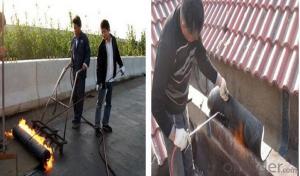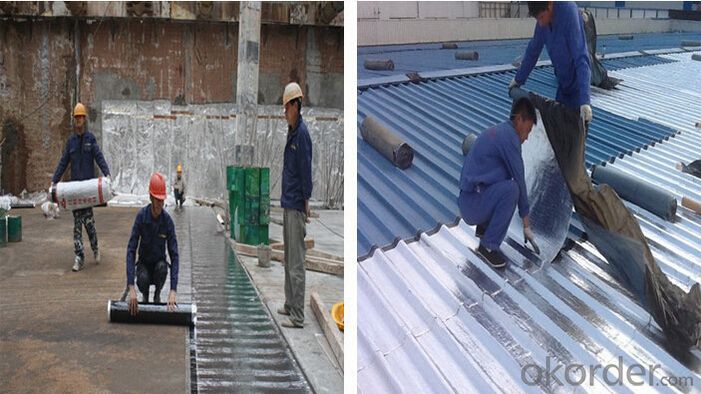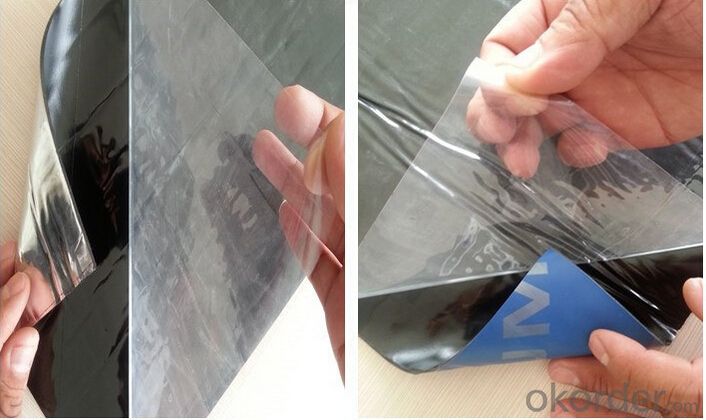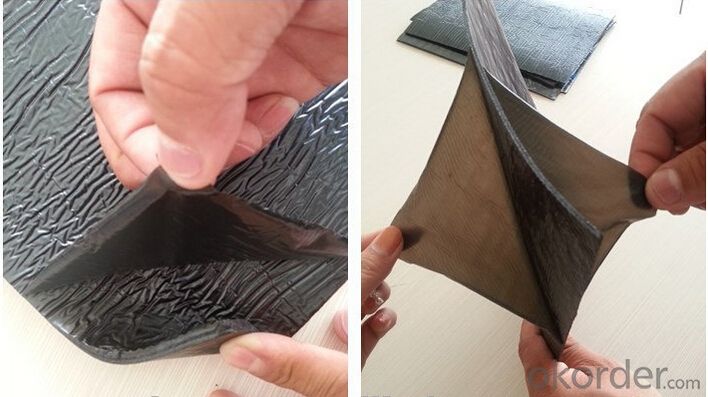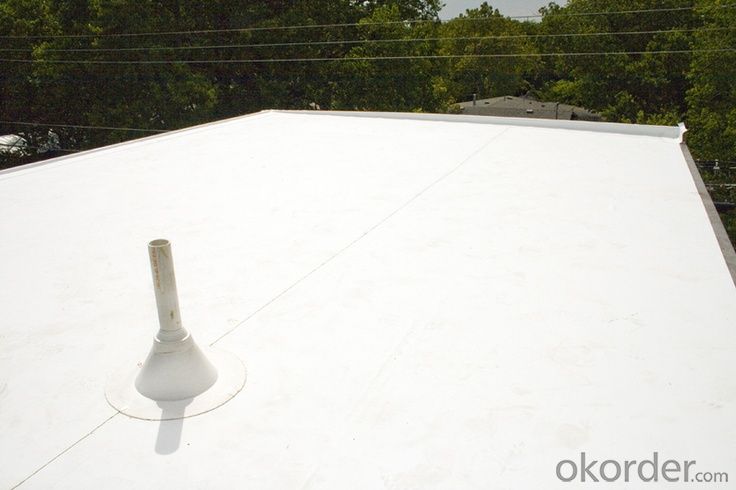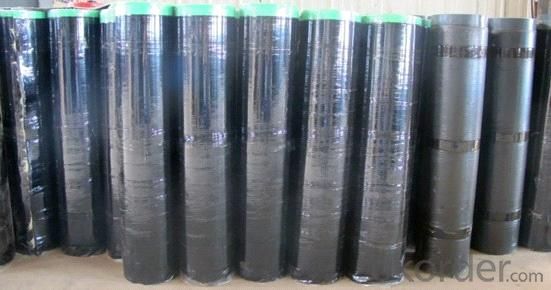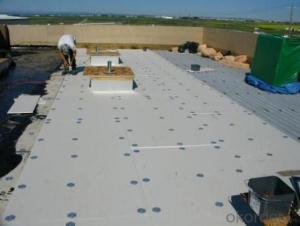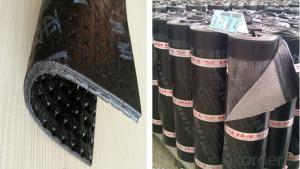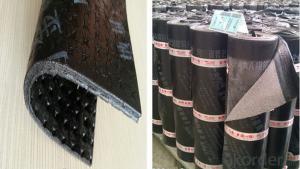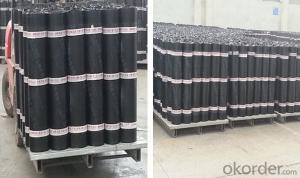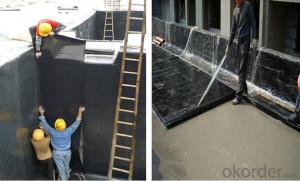SBS Modified Bitumen Waterstop Membrane For Roof
- Loading Port:
- Shanghai
- Payment Terms:
- TT OR LC
- Min Order Qty:
- 2000 m²
- Supply Capability:
- 200000 m²/month
OKorder Service Pledge
OKorder Financial Service
You Might Also Like
product description:
CE approved waterproof membrane price , self adhesive textured roll sbs waterproof membrane take the “Skin” type waterproof thought, according to the features of construction site, on the basis of width elastomeric modified bitumen waterproofing membrane, combining with features of wet-application self-adhesive membrane, use advanced equipment to produce 2 meters width that WP-SBS wet-application width elastomeric modified bitumen waterproofing membrane (Hereinafter referred to: WP-SBS membrane).WP-SBS is made of bitumen modified with Styrene-Butadiene- Styrene (SBS)as dipping and painting. Its upper surface covers PE membrane and color sand or schist, and lower surface is made of isolation material. Products correspond to the national standards GB18242-2008(elastomeric modified bitumen waterproofing membrane), paste by cement or cement mortar, and construct on the wet base, achieving tight and full adhesion with substrates, eliminating fluid-channeling layer, all above contribute to making a reliable “Skin” type waterproof system, which is a breakthrough innovation in ordinary modified bitumen membrane.
Technical parameter
| Item | Specifications | ||||||||
| Geotextile Unit Weight (g/m²) | 300 | 500 | 600 | 700 | 800 | 900 | 1000 | 1100 | |
| Geomembrane Thickness (mm) | 0.25-0.35 | 0.30-0.50 | |||||||
| Nominal Fracture Strength (KN/m) | 2.50 | 7.50 | 10 | 12 | 14 | 16 | 18 | 20 | |
| Breaking Strength (KN/m,≥,LD/TD) | 2.50 | 7.50 | 10 | 12 | 14 | 16 | 18 | 20 | |
| Standard Intensity Corresponding Elongation Rate (%) | 30~100 | ||||||||
| CBR Burst Strength (KN,≥) | 0.70 | 1.50 | 1.90 | 2.20 | 2.50 | 2.80 | 3.00 | 3.20 | |
| Longitudinal Tear Strength (KN,≥) | 0.05 | 0.25 | 0.32 | 0.40 | 0.48 | 0.56 | 0.62 | 0.70 | |
| Hydrostatic Pressve (Mpa) | See List Below | ||||||||
| Peel Strength (N/cm,≥) | 6 | ||||||||
| Vertical Permeability Coefficient (cm/s) | According to design or contract mentioned. | ||||||||
| Width Variation (%) | -1.00 | ||||||||
| Item | Geomembrane Thickness (mm) | ||||||||
| 0.20 | 0.30 | 0.40 | 0.50 | 0.60 | 0.70 | 0.80 | 1.00 | ||
| Hydrostatic Pressve (Mpa) | One geotextiles with one geomembrane | 0.40 | 0.50 | 0.60 | 0.80 | 1.00 | 1.20 | 1.40 | 1.60 |
| Two geotextiles with one geomembrane | 0.50 | 0.60 | 0.80 | 1.00 | 1.20 | 1.40 | 1.60 | 1.80 | |
Characteristic
1.Good impermeability
2.Possess good tensile strength, elongation and size stability which could be well suited the substrate distortion and crack.
3.Good performance in anti-strength, anti-resistance , anti-erosion, anti-mildew, anti-weathering
4.SBS modified bitumen membrane is specially being applied in the cold area with low temperature, while APP modified bitumen membrane is applied in the area with high temperature.
5.Convenient installation
Applicable scope:
It is widely used for civil building roofing, underground, bridge, parking, pool, tunnel in the line of waterproofing and dampproofing, especially for the building under high temperature.
Application method:
1.Make sure the roof deck smooth ,clean and dry(Moisture<9%),then apply the surface of roof deck homogeneously with a kind bitumen paint till dry to start application.
2.There are two methods in application:
One way is by heating and melting method---Heat the polyethylene film of the membrane and roof deck surface by heating and melting method to be nearly melted (not flowing),then install the membrane fully bonded to the roof deck with overlaps of 5-10cm.
The other way is by cold adhesive method---Pour the cold adhesive homogeneously on the roof deck then roll the membrane to install it to be fully sticked to roof deck.
By heating and melting method and by cold adhesive can be used in alternation in application as requested.
3.After application ,a full serious inspection is required to make sure no air bubble ,no fold,no falling away etc to guarantee the waterproof life.
Our Services
1.If you need some advises for the waterproof construction, we have the best engineer to serve you.
2.We send the free samples to you by freight collect.
3.We will guarantee the quality and the competitive price.
4.We will give you the best packaging and safe shipping.
5.If any problem, we will always be right here waiting for you.
Product usage of pe compound waterproof membrane
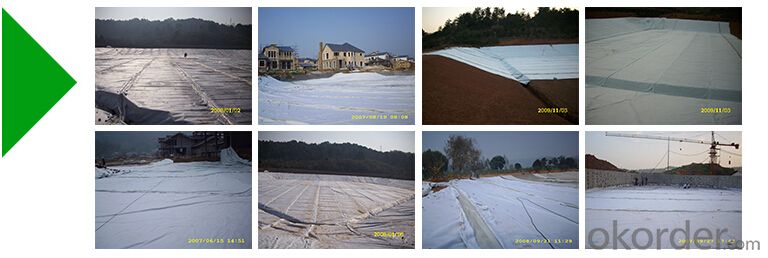
The products are widely used in projects of compound geomembrane impervious
Product line&test
♦Product line
From raw materials to finished products, every process is tested and controlled professionally and seriously by our professional machines and person.

Professional test machines ensure the products qualified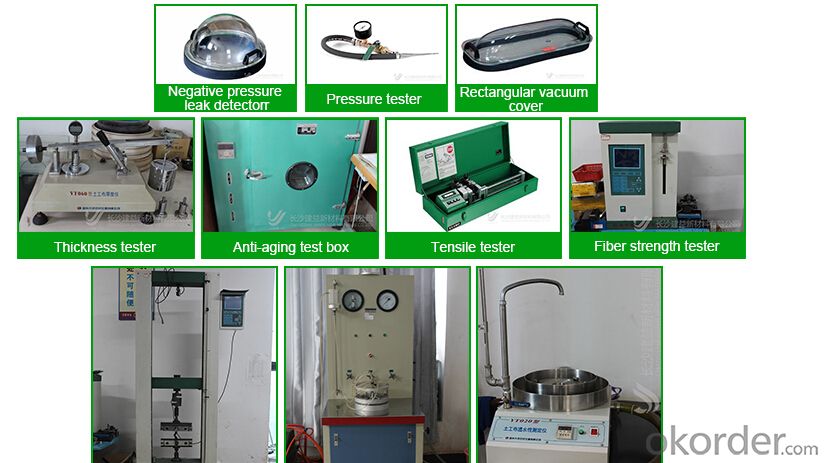 roduct certifications
roduct certifications
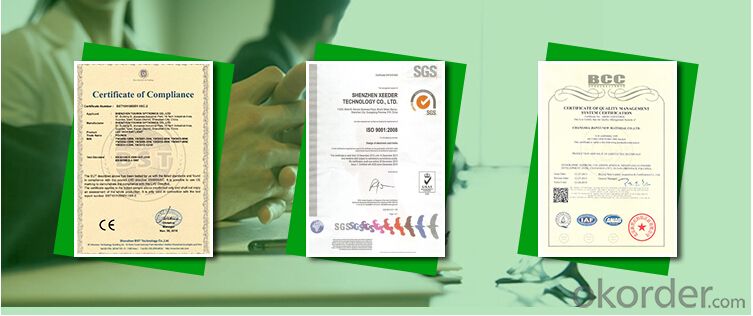
Inquiry Note
How to send an effective inquiry for saving your time?
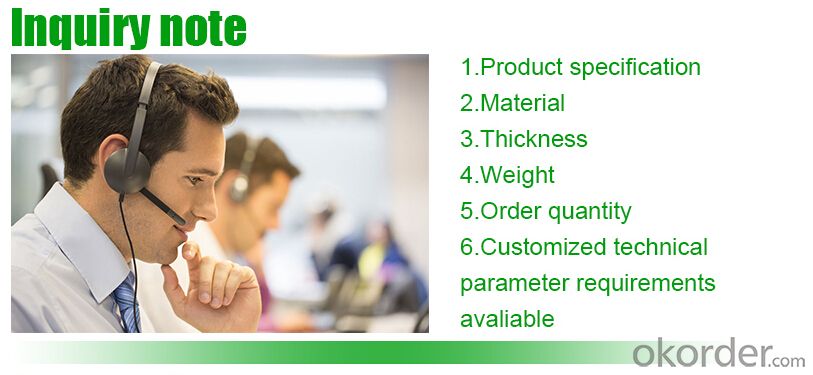

Packaging & Shipping
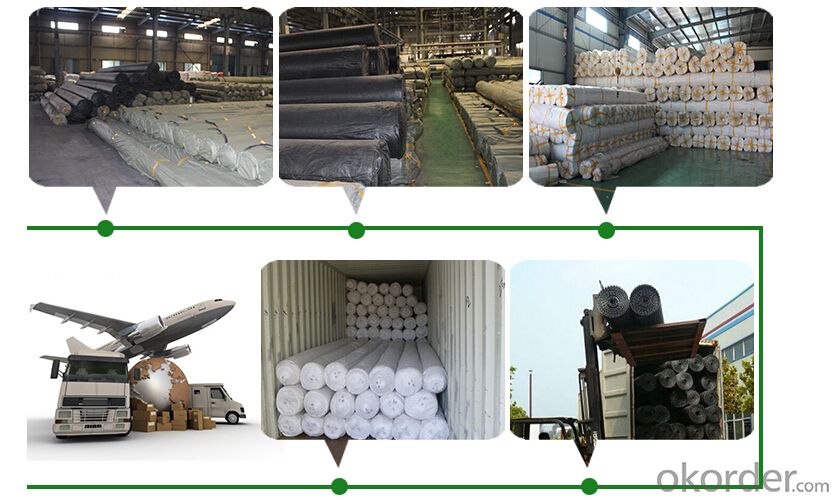
| Packing | Woven bag/PE bag packing or as customer request |
| Shipping | FOB Changsha,customized shipping terms and oppointed port accepted |
Why choose us ?
We have 20 years manufacturer experience
10000-30000 square meter factory size,more than 10 production lines
We will be your best partner,provide high quality products with CE,ISO,SGS
approved in competitive prive,sincerely hope to make a win-win cooperation with you.

FAQ

- Q: Can a waterproofing membrane be used in government or municipal projects?
- Absolutely, government or municipal projects can most certainly utilize a waterproofing membrane. It is, in fact, a vital element frequently employed in the construction or refurbishment of diverse infrastructure projects like roads, bridges, tunnels, and buildings. The purpose of waterproofing membranes is to thwart water infiltration, which may inflict harm upon the structure and undermine its stability. By incorporating a waterproofing membrane, government and municipal projects can guarantee the endurance and robustness of their infrastructure, thereby diminishing the necessity for costly repairs or replacements in the future. Furthermore, these membranes also contribute to energy efficiency by preventing moisture intrusion, thereby reducing the potential for mold growth and enhancing insulation properties. All in all, it is highly recommended to integrate a waterproofing membrane in government or municipal projects to elevate the lifespan and functionality of the infrastructure.
- Q: Can a waterproofing membrane be used for exterior foundation walls?
- Yes, a waterproofing membrane can be used for exterior foundation walls. Waterproofing membranes are specifically designed to provide a barrier against water penetration and can be applied to the exterior surface of foundation walls to prevent moisture infiltration. This helps in protecting the foundation from potential damage caused by water, such as leaks, cracks, and deterioration.
- Q: Can a waterproofing membrane be used for above-grade applications?
- Yes, a waterproofing membrane can be used for above-grade applications. Waterproofing membranes are designed to provide a barrier against water infiltration and can be applied to exterior walls, roofs, and other above-grade structures to prevent water damage.
- Q: Can a waterproofing membrane be used for tunnels?
- Yes, a waterproofing membrane can be used for tunnels. Tunnels are often exposed to water infiltration due to their underground nature, making waterproofing crucial to prevent water damage and ensure structural integrity. Waterproofing membranes, which are specially designed to provide a barrier against water penetration, can be applied to the tunnel walls, floors, and ceilings to create a waterproof seal. These membranes are typically made of materials such as bitumen, EPDM, PVC, or polyurethane, which are highly resistant to water and can withstand the constant exposure to moisture in tunnels. Additionally, waterproofing membranes can also provide protection against other potential sources of water ingress, such as groundwater or heavy rainfall. Overall, the use of a waterproofing membrane in tunnels is a reliable and effective method to maintain a dry and safe environment within the tunnel structure.
- Q: Can a waterproofing membrane be used in rooftop gardens or green roofs?
- Rooftop gardens or green roofs can benefit greatly from the utilization of a waterproofing membrane. It is, in fact, imperative to establish a dependable waterproofing system to safeguard the underlying structure against water-related harm. Acting as a hindrance, the waterproofing membrane effectively prevents any infiltration of water into the edifice or potential structural complications. Typically, this membrane is positioned beneath the soil or growth medium of the rooftop garden or green roof, guaranteeing adequate drainage and upholding the building's structural integrity. Furthermore, these membranes are specifically designed to endure exposure to UV rays, temperature fluctuations, and root intrusion, rendering them suitable for prolonged application in rooftop gardens or green roofs.
- Q: Can a waterproofing membrane be used on masonry surfaces?
- Yes, a waterproofing membrane can be used on masonry surfaces. In fact, applying a waterproofing membrane on masonry surfaces is a common solution to prevent water infiltration and damage. Masonry surfaces such as concrete, brick, or stone are porous and can absorb water, which can lead to structural damage, mold growth, and deterioration over time. A waterproofing membrane acts as a barrier, preventing water from seeping into the masonry and protecting it from moisture-related issues. It is important to choose a waterproofing membrane that is specifically designed for masonry surfaces and follow the manufacturer's instructions for proper application.
- Q: Can a waterproofing membrane be used on vinyl surfaces?
- Yes, a waterproofing membrane can be used on vinyl surfaces. The membrane serves as a protective layer that prevents water from penetrating and damaging the vinyl material.
- Q: Is a waterproofing membrane environmentally friendly?
- Yes, a waterproofing membrane can be considered environmentally friendly. Waterproofing membranes are designed to prevent water leakage and damage to structures, which can contribute to the longevity of a building and reduce the need for repairs or replacements. This can result in a reduction in construction waste and the overall environmental impact of the building industry. Furthermore, some waterproofing membranes are made from eco-friendly materials, such as recycled content or bio-based materials, which can help reduce the carbon footprint associated with their production. Additionally, these membranes can be designed to be recyclable or biodegradable, further reducing their environmental impact at the end of their life cycle. Moreover, by preventing water infiltration, waterproofing membranes can help protect the structural integrity of buildings, preventing moisture-related issues such as mold growth and rot. This can contribute to maintaining a healthy indoor environment and reducing the need for energy-intensive remediation measures. It is important, however, to consider the specific characteristics and certifications of a waterproofing membrane to assess its environmental friendliness accurately. Look for certifications such as LEED (Leadership in Energy and Environmental Design) or products that have undergone life cycle assessments to ensure that they meet rigorous environmental standards. In summary, while not all waterproofing membranes may be inherently environmentally friendly, the use of certain materials and the prevention of water damage can make them a sustainable choice for building projects.
- Q: Can a waterproofing membrane be installed on curved surfaces?
- Yes, a waterproofing membrane can be installed on curved surfaces. The flexibility and stretchability of the membrane allow for easy installation and adaptation to different surface shapes, including curved surfaces.
- Q: Can a waterproofing membrane be used in schools or educational buildings?
- Yes, a waterproofing membrane can definitely be used in schools or educational buildings. Waterproofing membranes are designed to prevent water penetration and protect the building structure from moisture damage. In educational buildings, where a large number of students and staff gather, it is crucial to maintain a safe and healthy environment. Waterproofing membranes can be used in various areas such as basements, roofs, walls, and foundations to prevent water leakage, dampness, and mold growth. By installing a waterproofing membrane, schools can ensure the longevity of their buildings, protect valuable equipment and resources, and provide a comfortable learning environment for students and staff.
Send your message to us
SBS Modified Bitumen Waterstop Membrane For Roof
- Loading Port:
- Shanghai
- Payment Terms:
- TT OR LC
- Min Order Qty:
- 2000 m²
- Supply Capability:
- 200000 m²/month
OKorder Service Pledge
OKorder Financial Service
Similar products
Hot products
Hot Searches
Related keywords
